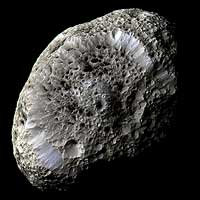
Saturn IV
Hyperion [hi-PEER-ee-en] has got to be one of the strangest moons ever observed close up. It is one of the smaller moons of Saturn and has a strange, spongy-looking body with dark-floored craters that speckle its surface. The Voyager spacecraft showed it to have a pock-marked body and the largest irregularly shaped satellite ever observed.
Hyperion might have had a major collision which blew part of the moon away. Its eccentric orbit makes it subject to gravitational forces from Saturn which have set it tumbling out of control. The moon's rotational period is not constant and varies from one orbit to the next. Hyperion is redder than Phoebe and closely matches the color of the dark material on Iapetus. The largest crater on its surface is approximately 120 kilometers (75 miles) in diameter and 10 kilometers (6.2 miles) deep. The irregular shape of Hyperion and evidence of bombardment by meteors makes it appear to be the oldest surface in the Saturn system.
New images of Hyperion taken by the Cassini Spacecraft on September 26, 2005 will for ever change our understanding of this new world. These pictures show a surface dotted with craters and modified by some process, not yet understood, to create a strange, "spongy" appearance, unlike the surface of any other Saturn moon. A color image reveals crisp details and variations in color across the strange surface that might represent differences in the composition of materials. Hyperion has a notably reddish tint when viewed in natural color.
Scientists are extremely curious to learn what the dark material is that fills many craters on this moon. Features within the dark terrain, including a 200-meter-wide (650-feet) impact crater surrounded by rays and numerous bright-rimmed craters, indicate that the dark material may be only tens of meters thick with brighter material beneath.
Scientists will also be examining Cassini's sharp views in hopes of determining whether there have been multiple episodes of landslides on Hyperion. Such "downslope" movement is evident in the filling of craters with debris and the near elimination of many craters along the steeper slopes. Answers to these questions may help solve the mystery of why this object has evolved different surface forms from other moons of Saturn.
The Cassini spacecraft flew by Hyperion at a distance of only 500 kilometers (310 miles). Hyperion is 266 kilometers (165 miles) across, has an irregular shape, and spins in a chaotic rotation. Much of its interior is empty space, explaining why scientists call Hyperion a rubble-pile moon.
| Hyperion Statistics | |
|---|---|
| Discovered by | William Cranch Bond |
| Date of discovery | 1848 |
| Mass (kg) | 1.77e+19 |
| Mass (Earth = 1) | 2.9618e-06 |
| Radius (km) | 205x130x110 |
| Radius (Earth = 1) | 3.2142e-02 |
| Mean density (gm/cm^3) | 1.4 |
| Mean distance from Saturn (km) | 1,481,000 |
| Rotational period (days) | chaotic |
| Orbital period (days) | 21.27661 |
| Mean orbital velocity (km/sec) | 5.07 |
| Orbital eccentricity | 0.1042 |
| Orbital inclination (degrees) | 0.43 |
| Escape velocity (km/sec) | 0.107 |
| Visual geometric albedo | 0.3 |
| Magnitude (Vo) | 14.19 |
 Odd World
Odd World
This stunning false-color view of Saturn's moon Hyperion reveals crisp
details across the strange, tumbling moon's surface. Differences in color
could represent differences in the composition of surface materials. The
view was obtained during Cassini's close flyby on Sept. 26, 2005.
Hyperion has a notably reddish tint when viewed in natural color. The red color was toned down in this false-color view, and the other hues were enhanced, in order to make more subtle color variations across Hyperion's surface more apparent.
Images taken using infrared, green and ultraviolet spectral filters were
combined to create this view. The images were taken with the Cassini
spacecraft's narrow-angle camera at a distance of approximately 62,000
kilometers (38,500 miles) from Hyperion and at a Sun-Hyperion-spacecraft,
or phase, angle of 52 degrees. The image scale is 362 meters (1,200 feet)
per pixel.
(Courtesy NASA/JPL/Space Science Institute)
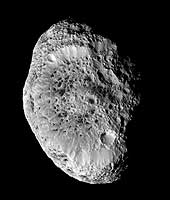 Cosmic Blasting Zone
Cosmic Blasting Zone
Saturn's impact-pummeled moon Hyperion stares back at the Cassini
spacecraft in this six-image mosaic, taken during the spacecraft's close
approach on Sept. 26, 2005.
This up-close view shows a low-density body blasted by impacts over eons. Scientists believe that the spongy appearance of Hyperion is caused by a phenomenon called thermal erosion, in which dark materials accumulating on crater floors are warmed by sunlight and melt deeper into the surface, allowing surrounding ice to vaporize away. At 280 kilometers, (174 miles) across, Hyperion's impact-shaped morphology makes it the largest known irregularly-shaped moon in the solar system.
Six, clear-filter images were combined to create this mosaic. Images were
taken by the Cassini spacecraft narrow-angle camera at a mean distance of
about 33,000 kilometers (20,500 miles) from Hyperion and at a
Sun-Hyperion-spacecraft, or phase, angle of 51 degrees. Image scale is
197 meters (646 feet) per pixel.
(Courtesy NASA/JPL/Space Science Institute)
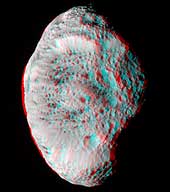 Spongy-looking Hyperion in 3D
Spongy-looking Hyperion in 3D
This 3D image of Saturn's amazing moon Hyperion was assembled from
pictures taken by the Cassini Spacecraft on September 26, 2005.
The moon has a spongy-looking appearance which is enhanced by looking
through 3D glasses.
(Copyright Calvin J. Hamilton)
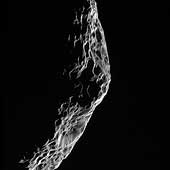 Hyperion: Parting Glance
Hyperion: Parting Glance
As Cassini sped away from its close encounter with Saturn's moon Hyperion
on Sept. 26, 2005, it took this parting shot of the battered moon's
shadowy limb.
The image was taken in visible light with the Cassini spacecraft
narrow-angle camera at a distance of approximately 32,300 kilometers
(20,000 miles) from Hyperion and at a Sun-Hyperion-spacecraft, or phase,
angle of 127 degrees. Image scale is 192 meters (630 feet) per pixel.
(Courtesy NASA/JPL/Space Science Institute)
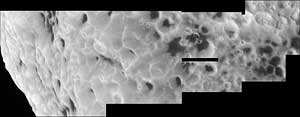 Hyperion's Unusual Craters
Hyperion's Unusual Craters
This high-resolution Cassini mosaic shows that Hyperion truly has a
surface different from any other in the Saturn system.
The mosaic is composed of five clear filter images taken during Cassini's close flyby of Hyperion on Sept. 26, 2005. The spacecraft passed approximately 500 kilometers (310 miles) above the moon's surface. Hyperion is 266 kilometers (165 miles) in diameter.
Scientists are extremely curious to learn what the dark material is that fills many craters on this oddball moon. Features within the dark terrain, including a 200-meter-wide (650-foot) impact crater surrounded by rays to the right of center and numerous bright-rimmed craters, indicate that the dark material may be only tens of meters (hundreds of feet) thick with brighter material beneath.
Scientists will also be examining Cassini's sharp views to try to determine whether there have been multiple episodes of landslides on Hyperion. Such "downslope" movement is evident in the filling of craters with debris and the near elimination of many craters along the steeper slopes. Answers to these questions may help solve the mystery of why this object has evolved different surface forms from other moons of Saturn.
The images comprising this mosaic were taken with the Cassini spacecraft
narrow-angle camera at distances ranging from approximately 8,500
kilometers (5,300 miles) to 4,600 kilometers (2,900 miles) from Hyperion.
Image scale is 26 meters (85 feet) per pixel.
(Courtesy NASA/JPL/Space Science Institute)
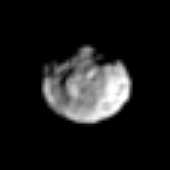 Hyperion's Nose
Hyperion's Nose
Several distinct craters on Saturn's moon Hyperion can be seen here, as
well as a protruding feature, perhaps a mountain, near the center.
Hyperion is 266 kilometers (165 miles) across.
The image was taken in visible light with the Cassini spacecraft
narrow-angle camera on March 16, 2005, at a distance of approximately 1.8
million kilometers (1.1 million miles) from Hyperion and at a
Sun-Hyperion-spacecraft, or phase, angle of 42 degrees. Resolution in the
original image was 11 kilometers (7 miles) per pixel. The image has been
contrast-enhanced and magnified by a factor of three to aid visibility.
(Courtesy NASA/JPL/Space Science Institute)
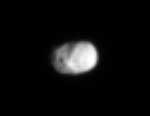 Oddball Moon
Oddball Moon
This image reveals the odd shape of Saturn's moon Hyperion and an
intriguing variation in brightness across its surface. The diameter of
Hyperion is 266 kilometers (165 miles).
The image was taken in visible light with the Cassini spacecraft narrow
angle camera on Oct. 20, 2004, at a distance of about 2.2 million
kilometers (1.4 million miles) from Hyperion and at a
Sun-Hyperion-spacecraft, or phase, angle of 50 degrees. The image scale
is 13 kilometers (8 miles) per pixel.
(Courtesy NASA/JPL/Space Science Institute)
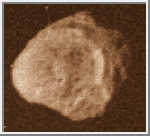 Hyperion
Hyperion
This image of Hyperion was acquired by the
Voyager 2 spacecraft on August 25, 1981.
(Credit: Calvin J. Hamilton)
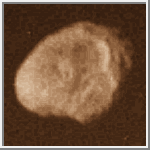 Hyperion
Hyperion
This image shows another view of Hyperion. It was acquired by the
Voyager 2 spacecraft on August 25, 1981.
(Credit: Calvin J. Hamilton)
 Simple Cylindrical Map of Hyperion
Simple Cylindrical Map of Hyperion
This map of Hyperion was created from Voyager 2 images of the satellite, and the shape
model of Peter Thomas. The map is centered at 180 degrees longitude.
(Courtesy A. Tayfun Oner)
 Topographic Map of Hyperion
Topographic Map of Hyperion
This is a topographic map of Hyperion. It is based upon the shape model by Phil
Stooke. As with all maps, it is the cartographer's interpretation;
not all features are necessarily certain given the limited data
available. This interpretation stretches the data as far as possible.
(Courtesy A. Tayfun Oner)

 Saturn
Saturn Titan
Titan Iapetus
Iapetus